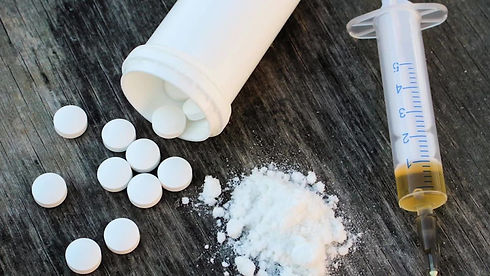Dangers of Fentanyl
Welcome to The Dangers of Fentanyl, a page dedicated to educating people about the risks associated with this powerful synthetic opioid. Fentanyl is a highly potent drug that is often prescribed to treat severe pain, but it is also frequently misused as a recreational drug. Unfortunately, fentanyl use has been on the rise in recent years, and it has become a major public health concern. In fact, the Centers for Disease Control and Prevention (CDC) reports that in 2019, more than 36,000 people in the United States died from overdoses involving synthetic opioids like fentanyl. This page provides valuable information on the dangers of fentanyl use, including its effects on the body, signs and symptoms of overdose, and how to get help for addiction. We also discuss the prevalence of fentanyl in street drugs and the importance of being aware of the risks when using any substance. Our goal is to help you understand the risks associated with fentanyl and how to protect yourself and your loved ones from harm. Whether you are struggling with addiction or simply want to learn more about this dangerous drug, The Dangers of Fentanyl is here to provide you with the information you need. So take a moment to explore our page, and please don't hesitate to reach out if you have any questions or concerns. We are here to help you stay safe and informed.


What is fentanyl?
Fentanyl is a powerful synthetic opioid analgesic that is similar to morphine but is 50 to 100 times more potent. 1,2 It is a Schedule Il prescription drug, 3 and it is typically used to treat patients with severe pain or to manage pain after surgery. Its sometimes used to treat patients with chronic pain who are
physically tolerant to other opioids.5 In its prescription form, fentanyl is known by such names as Actig®, Duragesic®, and Sublimaze®.5,6 Street names for fentanyl or for fentanyl-laced heroin include: Apache, China Girl, China White, Dance Fever, Friend, Goodfella, Jackpot, Murder 8, TNT, and Tango and Cash.

How do people use fentanyl?
When prescribed by a physician, fentanyl is often administered via injection, transdermal patch, or in lozenges. However, the fentanyl and fentanyl analogs associated with recent overdoses are produced in clandestine (illegal) laboratories. This non-pharmaceutical fentanyl is sold in the following forms: as a powder; spiked on blotter paper; mixed with or substituted for heroin; or as tablets that mimic other, less potent opioids. People can swallow, snort, or inject fentanyl, or they can put blotter paper in their mouths so that fentanyl is absorbed through the mucous membrane.

Why is fentanyl dangerous?
Opioid receptors are also found in the areas of the brain that control breathing rate. High doses of opioids, especially potent opioids such as fentanyl, can cause breathing to stop completely, which can quickly lead to death. The high potency of fentanyl greatly increases risk of overdose, especially it a person who uses drugs is unaware that a powder or pill contains fentanyl. Fentanyl sold on the street can be mixed with heroin or cocaine, which markedly amplifies its potency and potential dangers. The medication naloxone is an opioid receptor antagonist that reverses opioid overdose and restores normal respiration. Overdoses of fentanyl should be treated immediately with naloxone and may require higher doses to successfully reverse the overdose.

Saving Lives with Good Samaritan Law: Understanding Your Legal Protection When Seeking Medical Assistance During a Drug Overdose
RCW 69.50.315
Medical assistance Drug-related overdose Prosecution for possession.
(1) A person acting in good faith who seeks medical assistance for someone experiencing a drug-related overdose shall not be charged or prosecuted for possession of a controlled substance pursuant to RCW 69.50.4013, or penalized under RCW 69.50.4014, if the evidence for the charge of possession of a controlled substance was obtained as a result of the person seeking medical assistance.
(2) A person who experiences a drug-related overdose and is in need of medical assistance shall not be charged or prosecuted for possession of a controlled substance pursuant to RCW 69.50.4013, or penalized under RCW 69.50.4014, if the evidence for the charge of possession of a controlled substance was obtained as a result of the overdose and the need for medical assistance.
(3) The protection in this section from prosecution for possession crimes under RCW 69.50.4013 shall not be grounds for suppression of evidence in other criminal charges.
NOTES:
Intent-2010 c 9: "The legislature intends to save lives by increasing timely medical attention
to drug overdose victims through the establishment of limited immunity from prosecution for people who seek medical assistance in a drug overdose situation. Drug overdose is the leading cause of unintentional injury death in Washington state, ahead of motor vehicle-related deaths. Washington state is one of sixteen states in which drug overdoses cause more deaths than traffic accidents. Drug overdose mortality rates have increased significantly since the 1990s, according to the centers for disease control and prevention, and illegal and prescription drug overdoses killed more than thirty-eight thousand people nationwide in 2006, the last year for which firm data is available. The Washington state department of health reports that in 1999 unintentional drug poisoning was responsible for four hundred three deaths in this state; in 2007, the number had increased to seven hundred sixty-one, compared with six hundred ten motor vehicle-related deaths that same year. Many drug overdose fatalities occur because peers delay or forego calling 911 for fear of arrest or police involvement, which researchers continually identify as the most significant barrier to the ideal first response of calling emergency services."

